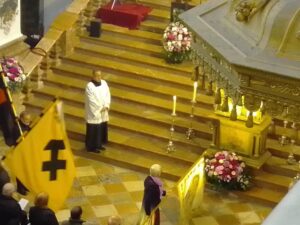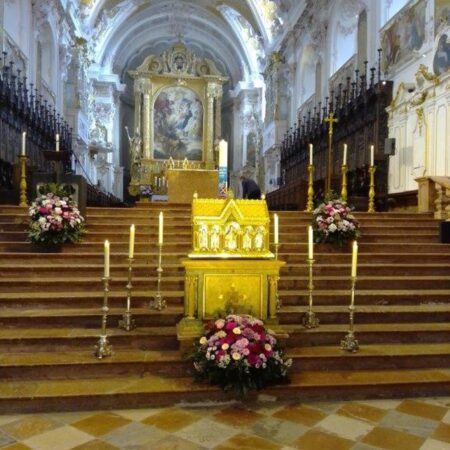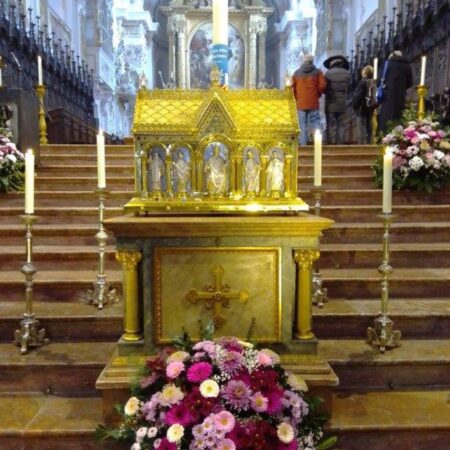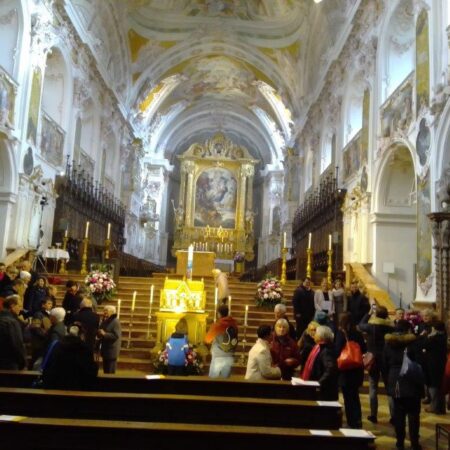A Special Experience to Begin
the Anniversary Year
I knew from a co-sister that the patron saint of the Archdiocese of Munich and Freising, St, Corbinian, is celebrated in a big way in November, with a pilgrimage of youth, among other things. In the year 2024, it will be thirteen hundred years since the arrival of the saint in Freising. In this anniversary year 2024, various events will be offered under the motto Live the Faith.
I wanted to be present on November 25, 2023 for the opening of this anniversary year. I was actually able to attend the St. Corbinian Fest for the first time and meet my two fellow sisters from Munich there; they were involved in the Advent Market.
The cathedral towers greeted from afar. Many people were streaming up the cathedral hill. I found a seat in the right gallery and had a direct view of the organ, choir, wind instruments and timpani – wonderful! The long, dignified procession of priests was impressive. The liturgy was varied: there were songs in Latin as well as modern songs and folk songs.
In his sermon, Cardinal Reinhard Marx explained that we would like to place particular emphasis on the sacraments, especially Baptism, in line with the anniversary motto “Live the Faith.” For that reason there exists a solemn renewal of Baptism, as, for example, in the Easter Vigil. Afterwards, the auxiliary bishop distributed holy water.
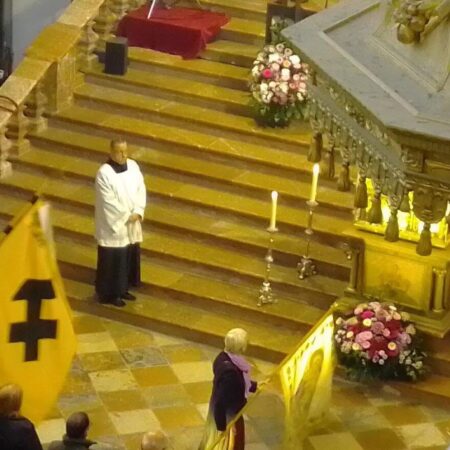
Cardinal Marx emphasized that Baptism is like a key that opens the door for us to faith. It is a gift, but we have to go through this door ourselves! The Holy Mass was joyful and hope-filled. The harvest is great, the Cardinal told us. We shouldn’t complain but trust in Jesus’ word and ask for workers.
My glance fell upon the banners of delegations: Isn’t that our image of Mary, the MTA next to the banner from Kolping? I have since learned that the Mother Thrice Admirable is indeed depicted on the flag of the “Association of German Catholic Women of Freising.” In the afternoon many families with children came for the blessing of children. In the Diocesan Museum there was a nice offer for children to make a little crèche.
There was a special Advent Market in the foyer. Various charities had set up stands, e.g. a children’s hospice, and “Paper of Peace” – an art project for migrants.
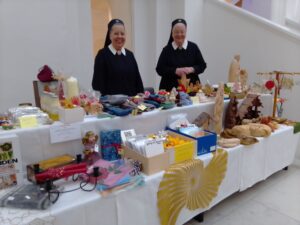
Our two Schoenstatt Sisters of Mary in Munich were also represented there. Their home-baked cookies and knitted socks were the most popular items!
A colleague [with whom I work in Dachau] had recently told me how beautiful the new exhibition is in the Diocesan Museum. By chance, I was able to join a guided tour there. As it turned out, the guide even knew me from Dachau; he told me that he used to give tours there. It was fascinating to listen to him.
I was especially impressed by how he explained some details with simple words so that, whether or not they were believers, his listeners could understand.
An example: Some paintings are not signed. Until a certain time (German Renaissance painter Durer)), it was not a custom to sign [a painting]. It was part of the artist’s humility not to be named- only on the invoice! The artist was to remember that his talents were a gift from God!
The guide noted how difficult and expensive it must have been to obtain special colors! Artists had to support their families through their work! There was competition. The rich rulers expressed their wishes and were very selective. This resulted in many beautiful pieces of art.
Ordinary people at that time could not undertake long journeys. Their only opportunity to absorb art was locally. So it is understandable that churches, for example, were richly adorned. At certain times they wanted to bring heaven closer, to direct the gaze upwards; for example, to convey hope after many wars.
The guide gave a very nice explanation of a small statue of the Immaculata. I was curious to learn what he would say. It was impressive to hear how he conveyed this mystery of faith with simple words. The small, precious statue was placed very intentionally in front of a window with a view to heaven. We were to pay attention to the folds of her clothing, the position of her hands and fingers; every detail had been carefully considered to convey unspoiled beauty and grace. How long the artist, Ignaz Guenther, must have worked on it!
In another area he drew our attention to two small putti. One of them is his favorite angel! It conveys wonderfully the lightness of eternal life, the way it “flies” – smiling, carefree – even the hairstyle contributes to this. I could have laughed: The angel has a little bun with a little pony tail – highly fashionable!
There was usually a short, concise text on the wall of each area. The text could be easily understood by everyone or was meant to encourage reflection about it.
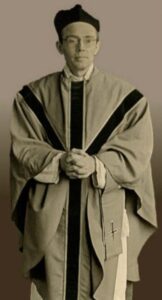
It seems to me the Diocesan Museum in Freising could be an exciting alternative for the Dachau Youth Project,” Walk in Their Footsteps!” P. Albert Eise SAC, – also a prisoner in Dachau – worked here as a young priest. After his release from Dachau, Father Joseph Kentenich was in Freising for about a week. There were encounters of Father Kentenich with the Schoenstatt Movement, including the Girls’ Youth at the Vinzentinum in Freising. The well-known photo of Father Kentenich without a beard was taken in Freising.
The young Josefa Mack made the dangerous journey from Freising to Dachau concentration camp for a year and a half to deliver food, mail, etc., especially to priests, particularly Polish priests. She smuggled the necessary things into the camp for the secret ordination of Karl Leisner on December 17, 1944. She was never discovered!
